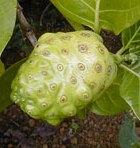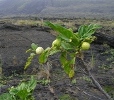Growing and Planting
Getting Started
Noni can be propagated from either seeds or stem
cuttings. Seeds have a
disadvantage due to the fact that they take 6-12
months or more to germinate while stem cuttings can
root within 2 months of being planted. Noni seeds
float and are hydrophobic due to an air chamber and
a water resistant seed coat. The seed are thick and
tough and has a cellophane-like coating.
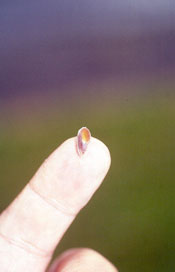
Notice the light brown
bubble toward the rounded end of the seed, this is
the air chamber that gives it its buoyant qualities.
Germination
The fruit of a noni can store hundreds of seeds.
Noni growers will rip the ripe fruit apart and
carefully separate the seeds from the flesh of the
fruit. Though the seeds can be plant right after
seeds are extracted from the fruit, most growers
will soak the seeds in water until they germinate
before planting the seeds in sterilized soil.
For agricultural purposes the noni need a hot, wet
environment to germinate. It can take up to a year
for a noni seed to germinate, but cranking up the
heat will reduce the time it takes them to
germinate. Noni seeds can withstand temperatures up
to 38 degrees Centigrade, sometimes higher yet. In
nurseries heating pads are used to heat up the potted
seed to create a shorter germination period.
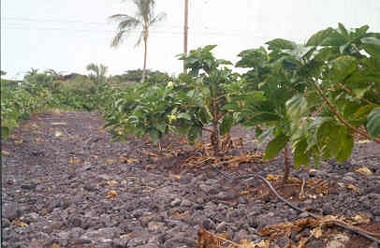
These noni are being cultivated in lava rock soil in
Hawaii, and are spaced about 6 to 8 feet apart.
Soil and Water
Wild nonis grow in forests and appear to
be fine and produce healthy fruit without the
benefit of fertilizers, but noni growers are
recommended to use a fertilizer program due to the
desire of massive fruit production. By adding
different amounts of nutrients at different stages
of the life cycle, it will encourage noni to grow the large
amounts of heath fruit. The plants should be
fertilized frequently with only small amounts of
fertilizer.
Chicken manure, macadamia nut husks and
crushed coral are effective organic fertilizers for
the noni plant and in some locations it is
recommended that a pound of lime per plant yearly
will encourage growth. Lava rocks are also use to
help promote growth since wild noni can grow in lava
fields. In an agricultural setting
the soil the noni grow in is sterilized to give the
plant's a clean start so the plant's don't have to
start fighting pathogens and parasites right away.
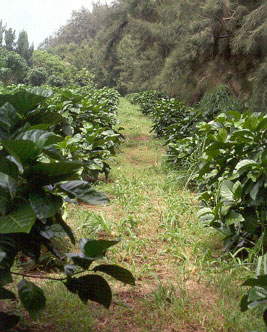
Noni tend to grow better in exposed area when
protect by a windbreak, such as these ironwood
trees.
Since nonis can survive droughts and are used to hot arid conditions, once the noni are mature, the plants only need to be watered once or twice a week. If the plant is older it is recommended to water it even less frequently, and each plant should get about 10 gallons of water each time it's watered. Overwatering can cause root damage caused by root rot and accelerate damage from root-knot nematodes.
